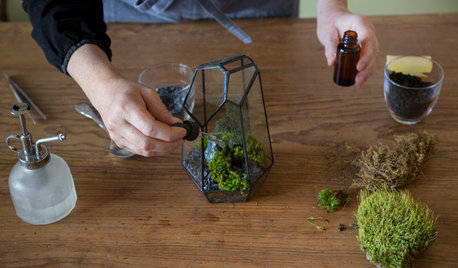Jars Cracked in Freezer
zabby17
17 years ago
Related Stories

DIY PROJECTSHoliday DIY: Mason Jar Forced Bulbs and Evergreen Gift Tags
Learn how to make these winter projects from the book ‘Garden Made’ by Stephanie Rose
Full Story
BLACKCooking With Color: When to Use Black in the Kitchen
Consider sampling Caviar or Cracked Pepper on your kitchen walls or cabinets for richness and impact
Full Story
KITCHEN DESIGNGet Organized for Holiday Baking
Before you crack that first egg, establish a game plan for stress-free success
Full Story
DIY PROJECTS20 Wonderfully Inventive DIY Projects by Houzzers
You'll never look at a wood scrap or empty jar the same way again. Borrow these ideas or just let them inspire your own project
Full Story
KITCHEN DESIGNKitchen Sinks: Fireclay Brims With Heavy-Duty Character
Cured at fiery temperatures, fireclay makes for farmhouse sinks that just say no to scratches and dents
Full Story
ORGANIZINGOrganizing Secrets: It’s the Little Things
Get these 8 small areas under control for a major boost in overall tidiness at home
Full Story
FEEL-GOOD HOMESimple Pleasures: Make Do and Mend
Experience the satisfaction of fixing, repurposing and creating things yourself around the home
Full Story
CRAFTS20 Ways to Organize Your Craft Space
Tired of looking for a needle in a haystack? Giving tools and supplies a proper place steps up productivity and cuts down on frustration
Full Story
BATHROOM COLOR12 Gorgeous Black and White Bathrooms
Luxurious materials, vintage touches and thoughtful color splashes make these chic spaces worth borrowing ideas from
Full Story
DIY PROJECTSHouzz DIY: Make a Mini Moss Sanctuary
This easy-to-assemble terrarium brings the joy of moss to your tabletop or shelf
Full Story


zabby17Original Author
bb
Related Discussions
reusing lids in freezer, old jars
Q
Need information on lids for freezer jars.
Q
old Ball freezer jars, 14 oz, 22 oz
Q
When Storing Seed in the Freezer Question
Q
melva02
annie1992
gardenlad
zabby17Original Author
jimster
gardenlad
melva02
CA Kate z9
jimster
gardenlad
melva02
zabby17Original Author
melva02
readinglady
CA Kate z9
bejay9_10
david52 Zone 6
shammierock
readinglady
zabby17Original Author
readinglady
CA Kate z9
david52 Zone 6
zabby17Original Author
david52 Zone 6
mellyofthesouth
bejay9_10
jimster
david52 Zone 6
gardenlad
readinglady
annie1992
annie1992
bejay9_10
readinglady
melva02
mellyofthesouth
plot_thickens
gardenlad
readinglady
gardenlad
zabby17Original Author
zabby17Original Author
jimster
melva02
gardenlad
david52 Zone 6
zabby17Original Author